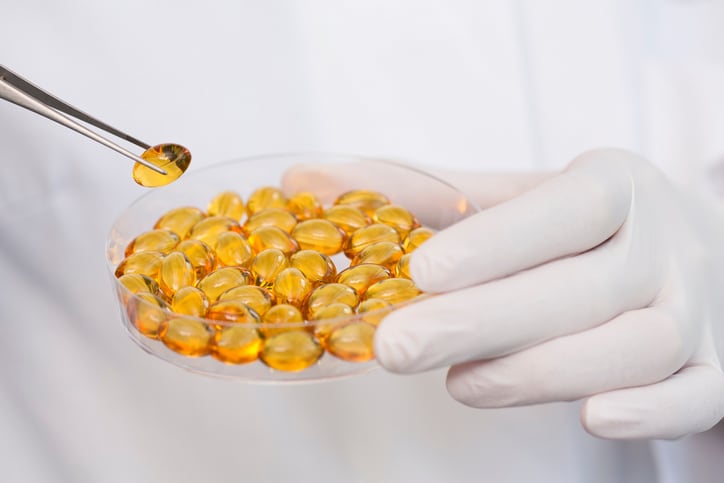Gerard Bannenberg, GOED’s director of technical outreach and compliance, provided an update on the latest results from GOED’s randomized testing programme during the organisation's biannual Exchange conference, hosted in Athens, Greece from Jan 22 to 25.
Every year, GOED tests 20 to 24 products via Eurofins labs then reaches out to the owners of the products to provide feedback to improve product quality. The organization provides an overview of the data to member companies, maintaining the confidentiality of the specific products tested.
Omega-3 content
With regard to label claim compliance, the mean of all tested products was 103% of stated EPA/DHA and 106% of total omega-3s. Of all the products tested, 61% contained at least 100% of their claimed EPA/DHA, while 69% contained at least 100% of total claimed omega-3’s.
All products, apart from three "bad" products, provided at least 80% of their label claim which Bannenberg described as "pretty good".
Looking into oxidation markers, the data did not find any link between oxidative quality indicators and time until end of shelf life, which he suggested "could be interpreted as products having a higher oxidative stability than you might intuitively expect".
Contaminants
In 2023, the contaminants testing included: heavy metals, dioxins and furands, PCBs, polyaromatic hydrocarbons (PAH; four species), per/polyfluor4oalkyl substances (PFAS; 23 species), bisphenol A, 3-monochloropropanediol (3-MCPD) esters and glycidyl esters, phthalates (plasticizers; 34 species), mineral oil saturated hydrocarbons (MOSH) and mineral oil aromatic hydrocarbons (MOAH).
There was 100% compliance for heavy metals, persistent organic pollutants, PAH and PFAS. "That’s pretty amazing," Bannenber said. "For a scientist, seeing 100% compliance is incredible."
However, looking at plasticizers, 60% of the products tested contained low but measurable levels of one or more phthalates.
"Plasticizers typically occur due to the contact with plastic, so check your operations and check for contact between oils and plastic materials," Bannenber advised.
MOSH and MOAH
The European Commission has been discussing the adoption of regulations to set legally binding limits for MOAH and MOSH, and in 2022 it decided on a limit of 2 mg/kg MOAH in oils.
Members states have agreed to withdraw and, if necessary, recall products above this limit while there are ongoing discussions to make this a legally binding limit (likely to be in place Q1 2025).
"Europe wants to get rid of mineral oils from food – that’s the baseline premise that we have to accept here," Bannenberg said. "This is really a challenge for the food industry in general and for edible oil in particular."
He noted that some GOED members have no issue with MOSH and MOAH in their products but that others cannot produce a single batch of omega-3 without significant levels of MOSH and MOAH.
"And then we have members with such challenges with the analytical issue of quantifying the contaminants that they can’t make any sense of the results they get—there's so much interference with these contaminants it's impossible to quantify," Bannenberg added.
Looking at MOAH levels in products sold in the EU (21 tested), GOED found 86% compliance, meaning those products met the discussed action limit of 2 mg/kg.
"So that's actually very promising," Bannenberg said. "It suggests brands in this market are already being selective with the oils they put on the market."
For products sold worldwide (51 products), just 57% of products meet that limit of 2 mg/kg. Whilst there is no limit outside the EU, Bannenberg warned that the new 2 mg/kg limit being discussed in Europe is likely to be rolled out elsewhere in the world.
"There is currently no regulation on MOSH, but the European Commission, through a stakeholders forum that took place last week, made an announcement, a proposal for an indicative level for MOSH, which signals to food authorities when levels of MOSH are above 10 mg/kg, there may be a request for additional information about the product with regards to how the company plans to mitigate the levels of MOSH in those products."
And here he warned that the outlook is not promising. Just 33% of products in the EU and just 18% of products worldwide had less than 10 mg/kg MOSH content.
He warned the situation may get even worse as the scarcity of high quality oils forces refiners to look at lower quality oils.
“Meeting these proposed limits from the EC is going to be a real challenge for our sector,” he said.
He noted that there is a big issue with analytical methods, inter and intra-laboratory variability, and difficulty distinguishing these contaminants from natural interferences such as terpenes and other compounds, which behave like them.
"EC recommendations take an 'as low as reasonably achievable' approach so they take the limit of quantification as the maximum limit which leaves very little space to mitigate these compounds or optimise processes to reduce these compounds especially when they are close to the limit of quantification.
"So we are waiting for improvement here and hopefully we can make active contributions to better, more sensitive, more accurate, analytical methodology."
Overall, he said that GOED members are doing very well with respect to omega-3 levels, label claim compliance and oxidative quality and have excelled on GOED Monograph contaminants.
“We need to keep an eye out with regard to Bisphenol A and plasticizers and then with regard to mineral oil hydrocarbons, we need mitigation efforts, maybe at a sectorial level or sub parts of our sector, and I would say a very interesting year lies ahead for us,” he added.


